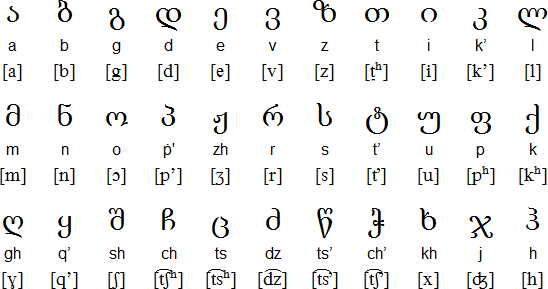
The other day, I decided to attend a lecture on the Georgian alphabet, which you can view here, to put myself through the extremely challenging exercise of learning more.
During the lecture, I and my fellow attendees were introduced to the thirty-three characters that make up the script. All were presented in one single session and the lecturer taught us the spellings and the sounds they represented. He didn’t, by the way, teach us any letter names, a point I’ll return to later.
In the course of presenting these sound-spelling correspondences (SSCs), the presenter, to give them a context, took pains to situate them in the context of real Georgian words. Thus, after only two or three SSCs, he was able to teach a few words, which we had to decode before he translated from Georgian.
What became very obvious almost immediately is that only a small number of people attending the lecture had the necessary prior knowledge to enable them to keep up with being able to decode words the presenter was, by now, presenting. The majority were left floundering after the first three or four spellings – for entirely understandable reasons!
Firstly, the Georgian alphabet script bears no relation to the Roman alphabet. Thus, every single letter symbol has to be studied carefully so that the contours of each letter can be recognised and, as more are introduced, differentiated from others. As most people did not yet have a schema for Georgian print, working memory was quickly overwhelmed and people gave up trying to decode even simple words which were comprised of what had gone before plus one more.
This is interesting because the people attending the lecture were (mostly) people who already could speak multiple languages and were committed language learners. Yet, with nothing to anchor to their prior knowledge of other languages and how their scripts work, they were lost. What made things even harder for everyone is that the Georgian alphabet script doesn’t resemble any other alphabetic script: it belongs to the Kartvelian family of languages group, which is not known to be related to any other language family in the world. In that sense, the task was not unlike that facing a young child confronted with learning to read and write for the first time.
So, what would the presenter have to have done if the attendees had wanted to extend themselves by actually learning the Georgian script? He would have to had to confine himself to teaching only two or, at most three symbols. In regard to teaching phonics, this is what is meant by teaching in small steps. Even then, simply looking at the unique orientation of the letter symbols isn’t enough. To make us focus on the exact bearing of each letter, the thing that helps enormously is to write it. And, saying the sounds as they are written, thus strengthening the link between sound and spelling, spelling and sound, helps even more.
Incidentally, it isn’t difficult to see how trying also to teach the letter names only adds to the complexity of trying to learn the script. This is especially so because the names of the letters don’t, at this point, add anything significant to what we need to know.
Next, what is required is a copious amount of practice because even when we, as experienced writers, had written only three or four symbols, it was very hard to recall any of them with any degree of accuracy even after only a very short period of time. For most people, the act of reproducing them from memory was virtually impossible.
In this way, during the periods of practice, errors and misunderstandings can be dealt with immediately. Further exposure to what has been learnt can be re-rehearsed later in the day and at the beginning of the next day before another sound-symbol is added.
From a conceptual point of view, what does help, of course, is the fact that, as already accomplished readers and writers, the attendees knew that each letter symbol represented a sound, something young children entering school don’t yet understand at all or have only a burgeoning knowledge of.
The relatively easy thing about learning the Georgian script is that it has thirty-three letters, most of which represent a single sound. In other words, the writing system is very transparent: if a symbol represents the sound /b/, it always stands for that sound and there are no other ways of spelling it: the logic of the code doesn’t change!
However, if even highly committed language learners coming to the Georgian script with little or no prior knowledge can begin to flounder after the introduction of only a few sound-spelling correspondences, how much more difficult is it for young children entering school to learn to read and write English from scratch. Unless young children are given the kind of practice that makes clear the logic of the English writing system, teaches the skills needed to use it, and teaches the links between sound and symbol, symbol and sound in cumulative steps, very many children will not acquire the knowledge needed to become proficient readers and writers.
So, how can this be achieved so that all children learn to read and write successfully? The lessons we can learn from this exercise are an important pointer in showing us how we should be teaching young children entering school.
In my next post, I am going to draw on this experience to show exactly what we need to be doing to ensure that all children can be taught to read and write.